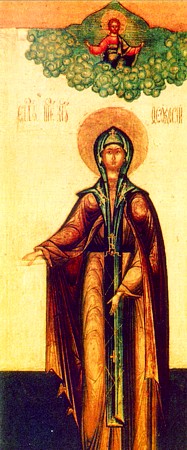
The Monastic Martyress Theodosia
Commemorated on May 29
The Monastic Martyress Theodosia lived during the VIII Century. She was born through the fervent prayer of her parents, and after their death, she was raised at the Constantinople women's monastery in honour of the holy Martyress Anastasia. Saint Theodosia accepted monasticism at the women's monastery after she distributed to the poor of what remained of her parental inheritance. Part of the money she used for writing icons of the Saviour, the Mother of God and the Martyress Anastasia. When Leo the Isaurian (717-741) ascended to the imperial throne, and being a fierce persecutor of icon-veneration, he issued an edict to destroy holy icons everywhere. At Constantinople there then existed gates called the "Bronze Gates", and up over them for more than 400 years was a bronzen image of the Saviour. In the year 730 the Iconoclast pseudo-patriarch Anastasias gave orders to remove the image. Orthodox people, at the head of which was the Monastic-Martyr Theodosia together with other nuns, rushed to the defense of the icon and toppled the ladder with the soldier atop, who was carrying out the command. The pseudo-patriarch Anastasias, fearing that the riot would intensify, informed the emperor about the incident, on whose orders soldiers went around beating up all the nuns, and Saint Theodosia being a very ardent defender of icons was locked up in prison. Over the course of a week they each day dealt her an hundred lashes, and on the eighth day they led her about the city, fiercely beating her along the way. One of the soldiers began to strike at the martyress and inflicted upon her a mortal wound, from which the martyress immediately died. The body of the holy monastic martyress, left cast upon the ground, was reverently buried by Christians in the Diokritis monastery in Constantinople. The place of burial of Saint Theodosia was glorified by numerous healings of the sick.

© 1996-2001 by translator Fr. S. Janos.